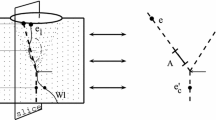Abstract
This paper assesses branching spacetime theories in light of metaphysical considerations concerning time. I present the A, B, and C series in terms of the temporal structure they impose on sets of events, and raise problems for two elements of extant branching spacetime theories—McCall’s ‘branch attrition’, and the ‘no backward branching’ feature of Belnap’s ‘branching space–time’—in terms of their respective A- and B-theoretic nature. I argue that McCall’s presentation of branch attrition can only be coherently formulated on a model with at least two temporal dimensions, and that this results in severing the link between branch attrition and the flow of time. I argue that ‘no backward branching’ prohibits Belnap’s theory from capturing the modal content of indeterministic physical theories, and results in it ascribing to the world a time-asymmetric modal structure that lacks physical justification.
Similar content being viewed by others
References
Aharonov Y., Albert D., Vaidman L. (1988) How the result of a measurement of a component of the spin of a spin-1/2 particle can turn out to be 100. Physical Review Letters 60(14): 1351–1354
Aharonov Y., Bergmann P., Lebowitz J. (1964) Time symmetry in the quantum process of measurement. Physical Review 134: 1410–1416
Aharonov Y., Popescu S., Tollaksen J. (2010) A time-symmetric formulation of quantum mechanics. Physics Today 63: 27–33
Albert D. Z. (2000) Time and chance. Harvard University Press, Cambridge, MA
Arntzenius F., Greaves H. (2009) Time reversal in classical electromagnetism. British Journal for the Philosophy of Science 60(3): 557–584
Belnap N. (1992) Branching space–time. Synthese 92(3): 385–434
Belnap N., Perloff M., Xu M. (2001) Facing the future: Agents and choices in our indeterminist world. Oxford University Press, Oxford
Black M. (1959) The “direction” of time. Analysis 19(3): 54–63
Davies P. (1977) The physics of time asymmetry. University of California Press, Berkeley, CA
Earman J. (1986) A primer on determinism. D. Reidel, Dordrecht
Earman J. (2002) What time reversal invariance is and why it matters. International Studies in the Philosophy of Science 16(3): 245–264
Earman J. (2008) Pruning some branches from “branching spacetimes”. In: Dieks D. (eds) The ontology of spacetime II. Elsevier Science, Oxford, pp 187–205
Elga A. (2001) Statistical mechanics and the asymmetry of counterfactual dependence. Philosophy of Science 68(3): 313–324
Farr, M. (2011). Temporal ontology on the two-time framework. Unpublished manuscript.
Farr, M., & Reutlinger, A. (2011). Difference making and the direction of time. Unpublished manuscript.
Hawking S. (1989) A brief history of time: From the big bang to black holes. Bantam Books, London
Ladyman J. (2000) What’s really wrong with constructive empiricism? Van Fraassen and the metaphysics of modality. British Journal for the Philosophy of Science 51(4): 837–856
Ladyman J., Ross D. (2007) Every thing must go. Oxford University Press, Oxford
Lewis D. (1979) Counterfactual dependence and time’s arrow. Noûs 13(4): 455–476
Malament D. (2004) On the time reversal invariance of classical electromagnetic theory. Studies in History and Philosophy of Science Part B: Studies In History and Philosophy of Modern Physics 35(2): 295–315
Maudlin T. (2007) The metaphysics within physics. Oxford University Press, Oxford
McCall S. (1976) Objective time flow. Philosophy of science 43(3): 337–362
McCall S. (1984) A dynamic model of temporal becoming. Analysis 44(4): 172–176
McCall S. (1994) A model of the universe. Clarendon Press, Oxford
McCall S. (1998) Time flow does not require a second time dimension. Australasian Journal of Philosophy 76(2): 317–322
McTaggart J. M. E. (1908) The unreality of time. Mind 17(68): 457–474
McTaggart J. M. E. (1927) The nature of existence. Cambridge University Press, Cambridge
Meiland J. (1974) A two-dimensional passage model of time for time travel. Philosophical Studies 26(3): 153–173
Montague R. (1974) Deterministic theories. Yale University Press, New Haven
Müller, T. (2009). Eliminating modality from the determinism debate? Models vs. equations of physical theories. In A. Hieke & H. Leitgeb (Eds.), Reduction–abstraction–analysis. Proceedings of the 31th international Ludwig Wittgenstein symposium (pp.~47–62). Frankfurt: Ontos Verlag.
Nerlich G. (1998) Falling branches and the flow of time. Australasian Journal of Philosophy 76: 309–316
Øhrstrøm P., Schärfe H., Ploug T. (2010) Branching time as a conceptual structure. In: Croitoru M., Ferré S., Lukose D. (eds) Conceptual structures: From information to intelligence. Springer, Berlin, pp 125–138
Placek, T., & Belnap, N. (2010). Indeterminism is a modal notion: Branching spacetimes and Earman’s pruning. Synthese. doi:10.1007/s11229-010-9846-8
Placek T., Müller T. (2007) Counterfactuals and historical possibility. Synthese 154(2): 173–197
Price H. (1996) Time’s arrow and Archimedes’ point: New directions for the physics of time. Oxford University Press, Oxford
Prior A. N. (1967) Past, present and future. Clarendon Press, Oxford
Reichenbach H. (1956) The direction of time. University of California Press, Berkeley
Schlesinger G. (1980) Aspects of time. Hackett Publishing Company, Cambridge
Smart J. J. C. (1980) Time and becoming. In: Van Inwagen P. (eds) Time and cause: Essays presented to Richard Taylor. Reidel, Dordrecht, pp 3–15
Smart J. J. C. (1995) Review of McCall (1994). Australasian Journal of Philosophy 73(1): 161–163
Wronski L., Placek T. (2009) On Minkowskian branching structures. Studies In History and Philosophy of Science Part B: Studies In History and Philosophy of Modern Physics 40(3): 251–258
Zeh D. (2007) The physical basis of the direction of time. Springer, Berlin
Author information
Authors and Affiliations
Corresponding author
Rights and permissions
About this article
Cite this article
Farr, M. On A- and B-theoretic elements of branching spacetimes. Synthese 188, 85–116 (2012). https://doi.org/10.1007/s11229-011-0046-y
Received:
Accepted:
Published:
Issue Date:
DOI: https://doi.org/10.1007/s11229-011-0046-y




